H. T. Webster was probably the best-known cartoonist in mid-20th century America.
Who, many of you are asking?
H. T. Webster.
His picture made the cover of Time magazine in 1945:
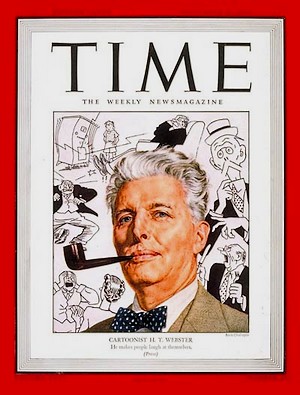
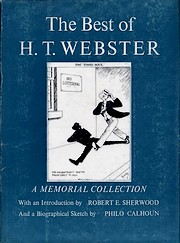 Webster published over 15,000 panels over the course of 40-plus years as a newspaper cartoonist. A memorial collection of his cartoons, The Best of H. T. Webster, published in 1953, a year after his death, featured an introduction by the Pulitzer Prize-winning author, Robert E. Sherwood, and made the best seller lists. In his introduction, Sherwood wrote,
Webster published over 15,000 panels over the course of 40-plus years as a newspaper cartoonist. A memorial collection of his cartoons, The Best of H. T. Webster, published in 1953, a year after his death, featured an introduction by the Pulitzer Prize-winning author, Robert E. Sherwood, and made the best seller lists. In his introduction, Sherwood wrote,
On April 4, 1953, the last new drawing by H. T. Webster was published in the New York Herald Tribune and a hundred and twenty-five other papers, and for many of us timid souls, this day marked as one of life’s darkest moments. There will be other fine artist-cartoonist-critics to inspire use with joy or indignation from day to day, but never another to span the years and the range of human emotions in the same extraordinary way that Webby did.
Webster based many of his one-panel cartoons on a number of recurring themes, and Sherwood managed to work two of them into his statement above.
“Life’s Darkest Moments” were, like many of his pieces, wonderfully succinct takes on the ways in which life consistently pokes a pin into the bubbles of our fantasies of self-importance.
Life’s Darkest Moments
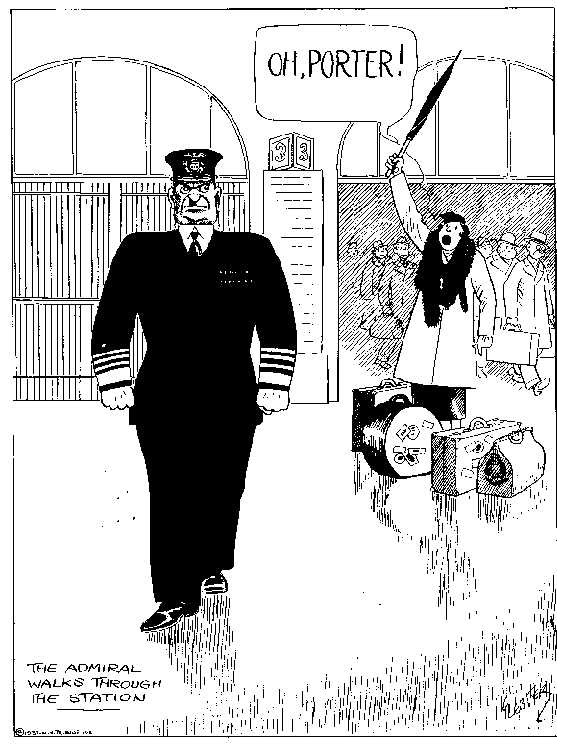
I had this happen to me the first time I flew home in my shining second lieutenant bars. While waiting at the baggage carousel, a woman walked up to me and asked if I was the driver and where my bus was parked.
But Webster also had a gentle sympathy for the big role that little things often play in establishing our sense of self, as illustrated in his cartoons titled, “The Thrill That Comes Once in a Lifetime.”
The Thrill That Comes Once in a Lifetime
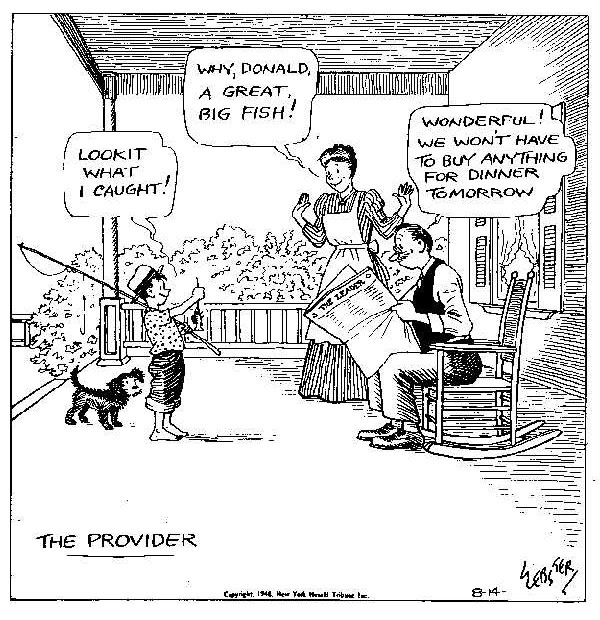
Another of Webster’s series was titled, alternately, “How to Torture Your Husband” and “How to Torture Your Wife.” These illustrated the remarkable capacity husbands and wives have for obliterating each other’s self-esteem with the most well-intentioned remarks:
How to Torture Your Wife

Some of his features, particularly those dealing with bridge, may not have aged as well as others. Many of these collected in The Best of H. T. Webster depend on more of a familiarity with terminology of the game than most people have today. Yet even some of the bridge cartoons work with no explanation at all:

But by far the best-known of all Webster’s series was “The Timid Soul,” which introduced a character whose name has outlived that of his creator: Caspar Milquetoast. “Millions of Americans,” wrote the uncredited author of Time’s cover story, “know Caspar Milquetoast as well as they know Tom Sawyer and Andrew Jackson, better than they know George F. Babbitt, and any amount better than they know such world figures as Mr. Micawber and Don Quixote. They know him, in fact, almost as well as they know their own weaknesses.”
As Michael Quinion writes on his World Wide Words site, “The name is just a Frenchified respelling of the old American English term milk toast, an uninspiring, bland dish which was created from slices of buttered toast laid in a dish of milk, usually considered to be food for invalids.” Like the dish, Milquetoast is uninspired, bland, and utterly lacking the ability to stand up for himself. He takes all forms of authority at face value:
The Timid Soul
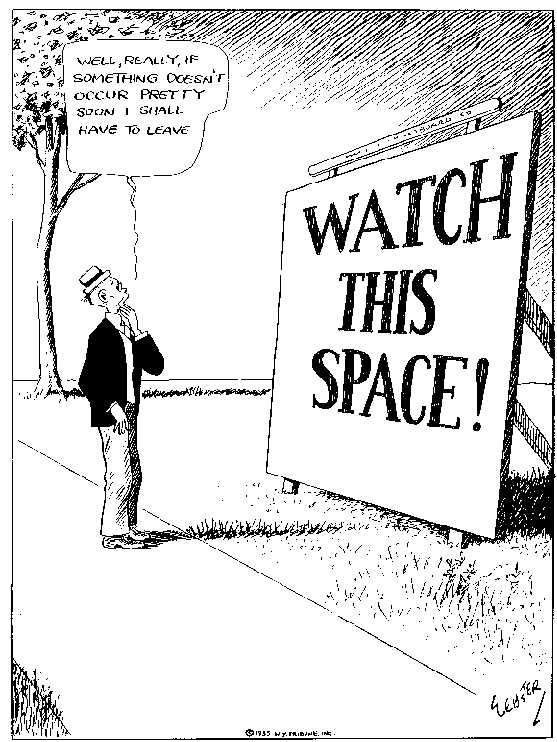
Webster himself described Milquetoast as, “the man who speaks softly and gets hit with a big stick.” Although at times he clearly understood that not speaking at all was the best way to avoid the big stick:
The Timid Soul

As Time’s writer noted, “In all Webster’s years of preoccupation with the psychology of timidity he seldom points up, even gently, the littleness, meanness and guile which timidity so often develops, and almost never touches on the propensity for bullying.” Perhaps this is one of the reasons Webster’s work has been so largely forgotten: at heart, Webster was too kind towards his subjects. As he so often showed in “The Timid Soul,” life has a way of bulldozing over the gentle and kind.
But that’s also why it’s refreshing to page through The Best of H. T. Webster Philo Calhoun, one of Webster’s close friends, who wrote the biographical sketch for the book, sums up his approach to his subject by quoting another writer’s description of the 18th century essayist and playwright, Joseph Addison: “His tone is never that of a clown or of a cynic. It is that of a gentleman, in whom the quickest sense of the ridiculous is constantly tempered by good nature ….”

@ Robert Singer – It is extremely unlikely that the “Harry” signature was from Webster himself. As mentioned in the forward of the posthumous “Best of…” book, Webster disliked his given name (Harold), and generally signed everything “Webby” or “Web”.
Sorry, I can’t help with this one.
I have a copy of To Hell With Fishing by Ed Zern. There is a personal note inside the cover, to a Clarance. from “Harry”. It also mentions a guy named Bill Mason. Anyway to find out if it is Webster?
I feel so enriched finding out about the cartoon character “Milquetoast”. His depiction of the timid person really resonates, especially in an era where abrasiveness, a la Donald Trump is sought after.
Hey, Librarian, thanks for that link. The term “milquetoast” was mentioned on a Yahoo group I’m in, and I immediately remembered by own copy of the H.T. Webster book, which I got from my parents. A wonderful book, and the humor still works. Got here via Google, and supplied the link for the page to the group I’m in.
Free full-text access to this book on The Internet Archive:
https://archive.org/details/bestofhtwebsterm00webs
I admire his work very much, and I used to have a copy of this collection.
I wish I still had it—I only started playing bridge a few years ago, and I am sure I would appreciate those drawings more now.
I just sent a note about Mr. Milquetoast to the Oxford English Dictionary, which traces the word “milquetoast” back to 1931, quoting from Calhoun’s biographical sketch to the effect that the character began in 1924 and was given a name in his third outing soon after. 1931 would also be the year of the first published collection of “The Timid Soul,” which by that time was Webster’s most popular featurette.
Does anyone know what his works are worth in todays market place? I have an August 11, 1945 Atom Bomb Drop Day original cartoon, titled “The Thrill that comes once in a Lifetime”. Stop in Route To Tokyo…on bottom left of cartoon. writing on back states that it is his original work and not a copy of sorts. I appreciate this find but my medications are very expensive and have to let things go
Someone in our house, probably my aunt who was a long-time member of the Book of the Month Club, had a copy of “The Best of H.T. Webster.” How I enjoyed looking at it from time to time. In his way, Webster was as good at deflating egos as “Mad Magazine” (another favorite “read” from my youth in the ’50s and ’60s). As a train buff, I naturally enjoyed the admiral mistaken for a porter, but also “The Thrill That Comes Once in a Lifetime” wherein a small boy chalks his name and hometown (Tomahawk, Wisconsin) on the side of a freight car. I found your site while searching for Webster’s “Bridge” cartoons. This was prompted by the bridge club that meets in our public library, mostly retired folks and all very casually dressed, in contrast to the long dresses and tuxes on the players in Webster’s cartoons. It’s a different world today, and not necessarily a better one. BTW, I still have the book and will make a point of getting it out later.
Yes, it’s a good example of just how much can be conveyed with just the eyes–and with just the slightest positioning of the eyes.
I remember during a high school study hall, my friend and I came across the word “milquetoast” in a magazine article and didn’t know what it was, so we looked it up. So seeing the origination come up again is a nice flashback. I like the sample panels that you posted and will have to seek out this book. I love the expression of the man in the Census “head of the household” panel.
I’m sure Webster was a regular feature–but he was never really aiming at an audience of kids, so your reaction is probably understandable. I never got what the big deal with “Pogo” and “L’il Abner” was when I read the funnies back in the 1960s.
I recognized the drawing style from my early childhood. Webster must have been syndicated in the St.Louis Post Dispatch, where I did my early funny paper reading. I believe that most of the panels baffled me completely — compared to Blondie, Nancy and Sluggo, and Little Henry.
I had never heard of Webster. I like his cartoons. Well done !